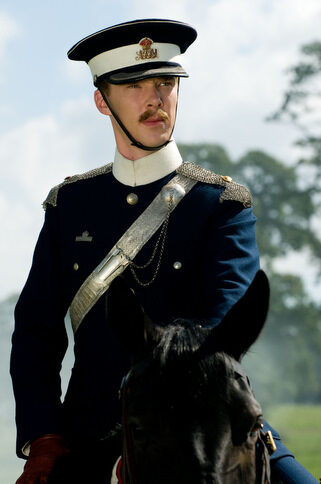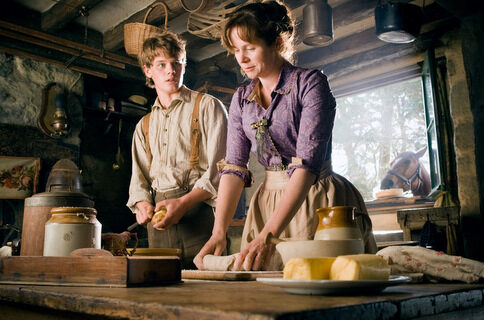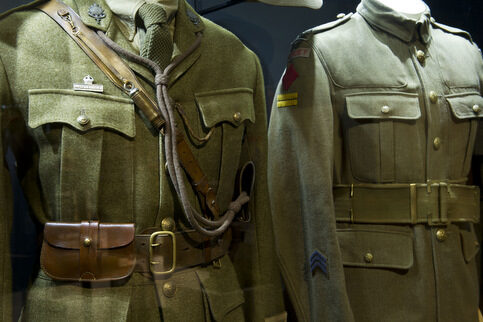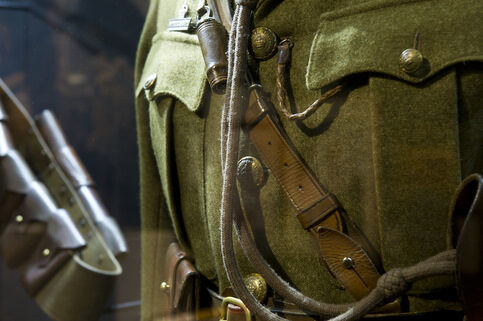War Horse: Interview with Costume Designer Joanna Johnston | Clothes on Film
Joanna Johnston is a multi-award nominated costume designer with an excitingly eclectic filmography. From Who Framed Roger Rabbit (1988), Back to the Future Part II (1989) and The Sixth Sense (1999) to About a Boy (2002) and Valkyrie (2008). Including most famously Saving Private Ryan (1998), she is now carving a niche in military dress and uniform. Although, considering the subtlety of all Ms. Johnston’s costume design – the cleverly unchanging ensemble worn by Bruce Willis in The Sixth Sense for example – this is only a small part of her work.
Clothes on Film called up Joanna Johnston for a chat about her most recently released project, War Horse (2011), her fifth with Steven Spielberg as director (six if you add Lincoln, due December). NB: typically with interviews of this type we would edit some of the conversation to keep it pertinent, but a good 75% of our discussion is retained here – really because it was so enlightening in regards to not only the costume designer’s role, but his/her thought processes too.
Clothes on Film, Chris: What attracted you to the project? Was it basically any opportunity to work with director Steven Spielberg again?
Joanna Johnston: Pretty much. I’d have to say, most of what Steven does, I’m interested in. Kathleen Kennedy (producer) went to London and took her daughters to see the stage show of War Horse. She then said to Steven “We should do this as a film. It is so up your street”. I think they got the rights, then Steven came to London and I was with him when he watched it. The story was utterly perfect for him, and I don’t think there was really any question for me.
I’d never done The First World War before. I have a picture of a great uncle of mine who had gone to the war aged about 18. He was a cavalry officer so similar to Captain Nichols (Tom Hiddleston). I had this photo with me all the way through the film; in fact, I sent it to Steven and it became quite symbolic. It was of my great uncle doing manoeuvres just before we went to war. His horse could have been Joey and he was all in uniform. The horse is coming forward to the camera and is looking absolutely beautiful, and he is turning back as if to say “What on earth is coming behind me?” He went to war and within 4 months he was dead, before his 19th birthday. He is buried in France. It’s a very poignant thing for me, so obviously my emotions were right in there at the beginning because I had this family history connection.

Benedict Cumberbatch as Major Jamie Stewart. Military uniforms for principals in War Horse were made at Costume Workshop in London.
CoF: So is it important to you that a project has an emotional pull?
JJ: Yes, there has to be something, and it can be quite random. It doesn’t even have to be something directly related, but there has to be something… like a key or a lucky talisman. When we did Saving Private Ryan I had the same connection again because my Dad went in on D Day, aged 19. These war pieces are the ones that get me most.
CoF: Have you carved out a niche for yourself for this type of film – the go-to costume designer for military epics?
JJ: Someone said that to me recently, that I’m kind of the military person. My dad would have LOVED that, because he was such a military person, and I come from a military lineage. But really with Saving Private Ryan I didn’t have a clue… I thought “Oh, uniforms, that’ll be easy”. I was stupid because it’s not easy! From the point of view of the audience, I don’t think uniforms get really recognised. But I feel a huge sense of responsibility to get it absolutely right, not only to honour the men who fought but to honour those who know. You don’t want to screw up on uniforms.
CoF: So you don’t feel the need to take any creative license with costumes?
JJ: No, not in these films. This is a serious subject matter. In certain films, I guess, but I’ve never done them, you could push it. But for me – no, I can’t. It’s in my DNA. Apparently the BBC get more complaints about costume faux-pas in uniforms than anything else. Costumes say subliminally what they’re meant to say. It’s like that piece you wrote about Sandy Powell on Hugo. I love that. I love her use of colour and the way she pushes that. That whole stylisation on the film was perfect. And for a lay-person, that is actually completely believable.
CoF: There’s a tremendous level of detail in War Horse, such as the German soldier helmets changing from spiked to the more traditional ‘Coal Scuttle’ style we are used to seeing. Does it ever frustrate you that most people will never notice that?
JJ: I’m just happy if four people in the world notice it. I do have to say as well, Chris, that I work with a remarkable man called David Crossman on all my military stuff. I’ll work with him on anything frankly, because he’s completely and utterly brilliant. He is a military encyclopaedia. On Private Ryan, he told me in a week or two weeks what would have taken me years to study. He can just say “These American troops at Omaha beach; they would be wearing this and this.” He did the same on War Horse. I couldn’t exist without him.

Albert Narracott (played by Jeremy Irvine) and his mother, Rose (Emily Watson). Costume designer Joanna Johnston was careful to ensure athletic actor Irvine did not appear too developed on screen – so befitting his character and situation.
CoF: I noticed on the British uniforms of the officers that they don’t all match, which they wouldn’t have done. Did this help you differentiate character, which must be very difficult when everyone looks so similar?
JJ: Yes. It’s tiny, tiny moves, but yes, there was a certain colour I wanted on Captain Nichols which was slightly softer, but Major Stewart (Benedict Cumberbatch) was a bit harder. It’s a mix and match that all adds up to something. My main thing was a slight softness on Nichols; there’s something poetic about him. I actually found this photograph that Tom Hiddleston absolutely adored. It was of an officer in France who’d obviously taken his terrier dog with him or adopted one. He was walking and leading his horse, and a little dog was standing on the back of his horse, and we so tried to persuade Steven to do this. We both felt, Tom and I, that this was so Nichols; this human touch that he was so kind and gentle and he loved all things, but Steven wasn’t having any of it. We did decide that we could have the dog in the little mess room. There’s that scene where Lt. Charlier Waverly (Patrick Kennedy) talks about his new hat with the silk lining. We got a dog but the room was so small that we never got to shoot the dog, he was on stand-by, and Tom and I were so sad. After all that, we never got the dog. I don’t know where it would have fitted-in… it probably would have been quite distracting!
CoF: Can you tell us briefly, for those that don’t know, how you begin your job in pre-production?
JJ: Research is my first thing. It’s usually pictorial research, but it could be fabric. I start to buy fabric and trims; even shapes can be an influence, and then pretty soon you’ve got to start designing and constructing. In the old days you probably had a lot longer lead-in, but now you’ve got to get started pretty quick – you can’t have too much dilly-dallying. My longest point of research on War Horse was in the Imperial War Museum. It was photographic research; I spent three solid days in there, and I didn’t even complete all my lists. One of my assistants had to pick up the slack. The war museum is in London but they have a huge collection of items in Duxford, so I went to just look and feel. It’s very evocative.
I got very obsessed with the officers’ boots; they were so beautiful. We made all of the boots. Luckily all of our officers had lovely long slim legs with narrow calves so they looked really good. All of the boots were made in London. When they’re made, they look quite crude but were finished later. The miraculous Steve Gell does all my dyeing and printing. He breaks them down, to look like the most divine chestnut or toffee leathers. They’re heavily polished to make them look as if they’ve been going for a while; he knows how to go through the process of ageing. Some of his stuff is printed; we did quite a complicated process on a waistcoat that was velvet to make it look like it was many years old. It’s finished, then broken down by him, and you can hardly tell it from a genuine vintage piece.

Military tunics from War Horse on display at the National Army Museum. Photograph by James McCauley.
CoF: How does the breaking down process work?
JJ: Well, the big stuff, like the uniforms, are very time consuming. You get the cloth, Steve (Gell) dyes the cloth, then that all goes to get made into uniforms. The whole thing is massaged all the way through, then it comes back to us. And then it depends on the weight and where it is in the story. At the beginning it could look pretty good, but by the time you get to the trenches, everything is pretty hammered. There is a lot of work that goes into making it look like that. With civillians’ clothes it’s piece by piece. I’ll say to Steve something like “I want it to look like he’s had it for ten years, or something like that, and this is what he has been doing with it. These are the stress points, and he may have had some stains from this or that”. There are specific things, like the grandfather’s (Niels Arestrup) clothes have stains from fruit. With every single item you need to think “What would that have been through?” to get it to look like what we see on screen.
CoF: I understand all the extras and secondary characters – their costumes were made in Poland?
JJ: Yes, they were made by Hero in Poland. I’ve just worked with them again actually for The Civil War because we’ve just done Lincoln (Steven Spielberg’s upcoming biopic of Abraham Lincoln). They’re brilliant. They do exactly what we want, to our requirements, in a remarkable speed of time. For instance, when we were in Berlin – did you see the film Valkyrie with Tom Cruise? I worked on that film. One of the guys from Poland, he was a catering guy on the train that went into Berlin. We had costumes that came in on a catering truck every day. We were going for a secondary principal, like “We need this costume done in three days. Here are the measurements, here is the cloth and here are the insignias”. They would make it and just send it back on the train.
The principals’ for War Horse we made at Costume Workshop in London. Of course, we had to have repetitions for all of them because things happen.

Close up detailing of tunic. Note the regimental buttons. Photograph by James McCauley.
CoF: How did the actors respond to wearing these costumes, especially Albert Narracott (Jeremy Irvine) wearing those very high waisted trousers?
JJ: The thing about Jeremy is we had to keep him looking youthful. And so, like you said, it was workwear. I notice you put in your review about ‘Old Town’. That was clever. With Jeremy it was about proportions. What’s interesting is when he first went into uniform I thought “Oh my God, he looks so young”. Uniforms play with your head. Him in uniform, it kind of breaks your heart. You can see the form of the body. He’s fit, Jeremy, and we had to counter-balance that so he didn’t look too developed. I love those workwear trousers but they’re not very comfortable. Jeremy was great. He’d never done anything like this before, so he just lay in our hands.
CoF: It was perhaps unusual that he wasn’t wearing a hat at the start of the story. Is that something you considered?
JJ: A cap, yeah. He did have a cap in one scene. I don’t know if you noticed. I was quite keen for him to have a hat. That was a Steven thing. Directors often don’t like hats; they feel they start taking over a bit. You don’t have the vulnerability of the face. In my original plotting, I would have had a hat in about half the scenes, but you know… it’s there. You’re right; if you look at period pictures of people his age, they would have had a hat.
CoF: Hats can become a bit symbolic if not everybody is wearing them.
JJ: No, you’re right. Hats, because they’re framing the face, they can make or break. A hat can become too invasive, but if it’s shadowing or haloing the head, it can look fantastic. But Steven works on the emotion in the face; he didn’t want anything to interfere with that. Another thing with a hat – practically, he can look a bit too ‘cool’. Jeremy is very good-looking. When he was in the cap, we did quite a few stills. He looked really great, and maybe that’s not the right thing. In the contemporary eye, it becomes a bit too considered.

Tom Hiddleston as Captain Nicholls. Quite deliberately, Nicholls’ overall colour palette is softer than Major Stewart’s to reflect his gentler personality.
CoF: What was the costume budget of War Horse? Can you tell me that?
JJ: Nooooooo! I’m not going to tell you that!
CoF: I recently wrote an article about Winter’s Bone (2010), and although the costumes weren’t period, they only cost $5,500. Did you see that?
JJ: Who did the costumes for that?
CoF: Rebecca Hofherr.
JJ: Oh yes, I’ve heard of her. It was very nicely done. The thing is I literally can’t tell you. I can’t remember. I’ve been through two films since War Horse, and I can’t recall the division of labour between the actual costumes. It was under a million, that’s all I’ll say. Considering the amount of stuff we had to mount up for the budget we had, we were pretty pleased with how well we did. This was an incredibly hard film but the engine was very smooth. It was quite extraordinary actually; I think everyone enjoyed it. It was hard, but good hard!
CoF: Obviously, you are known for working on more period films. Would you like to try your hand at more contemporary pieces in the future?
JJ; I don’t take a film because of when the story is set. I take a film purely for the story and the director. They’re kind of equal actually – the story and the director. I mean, if I love the script, I don’t care. Something like The Sixth Sense I did, or About a Boy; that was lovely because you can still do really interesting work to tell the story of who the people are, and I won’t do a film just because it’s from an amazing period if it doesn’t push the right buttons in the story. Funnily enough, I used to say I wasn’t very interested in medieval or science fiction, and I’ve just done the Bryan Singer film, Jack the Giant Killer (due March, 2013). I hope you’ll interview me for that, because that was just brilliant; the total opposite to War Horse. We designed absolutely EVERY SINGLE THING in it. I don’t know what it will be like, we’ll see, but then going from that to Lincoln… I feel really lucky because I’ve had three amazing projects in a row.
With thanks to Joanna Johnston.
War Horse is released on Blu-ray and DVD on 7th May.
© 2012, Chris Laverty.
Related Posts: